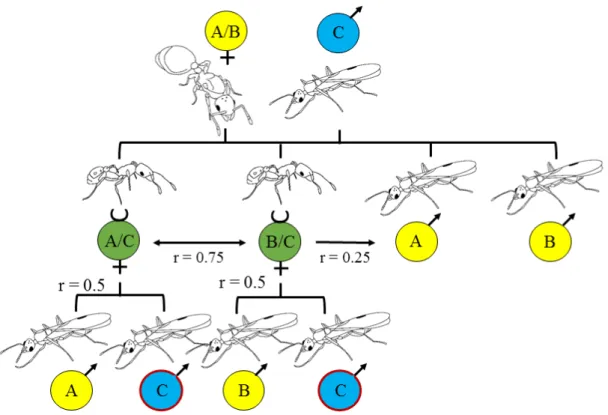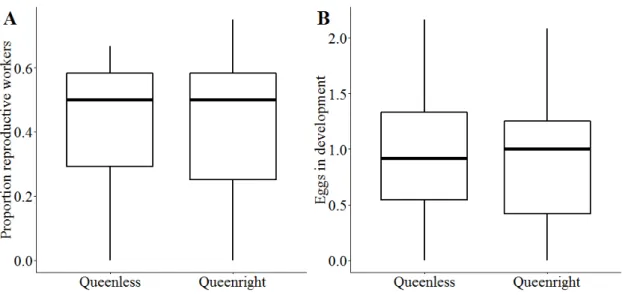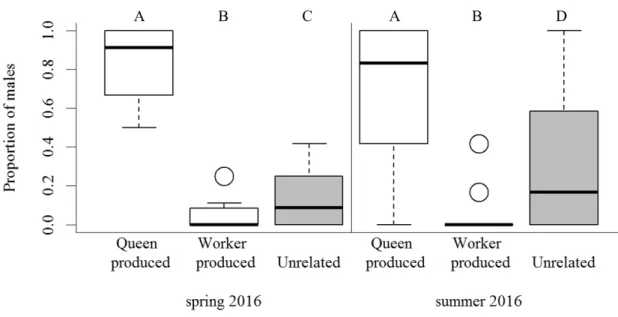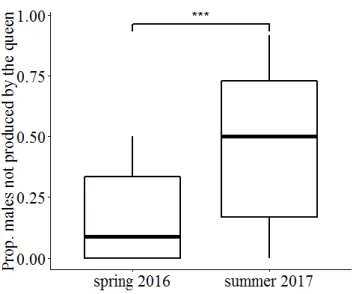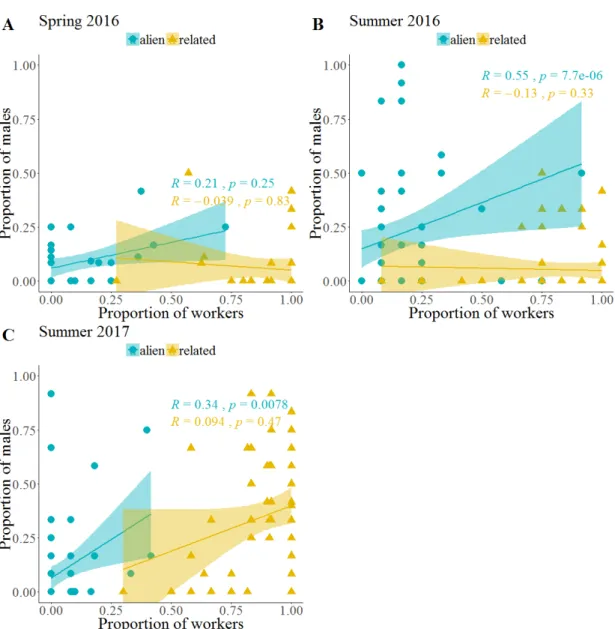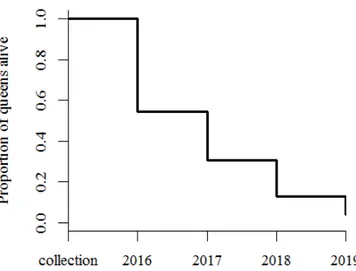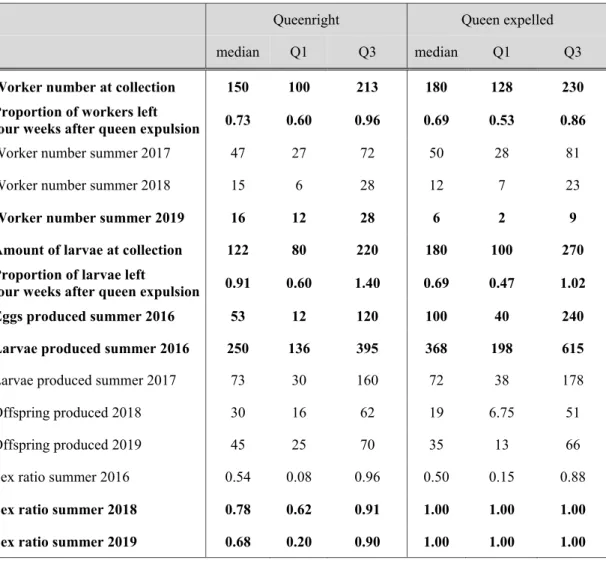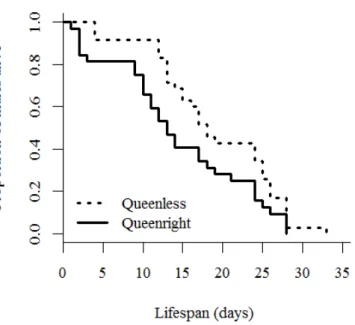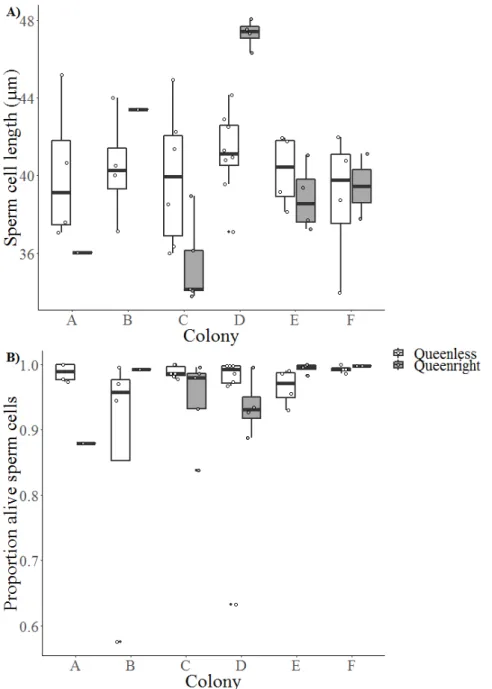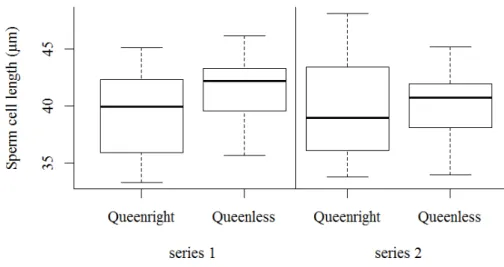The importance of direct fitness for helpers in advanced
social societies
Dissertation
zur Erlangung des Doktorgrades
der Naturwissenschaften (Dr. rer. Nat.) der Fakult¨ at f¨ ur Biologie und vorklinische Medizin der Universit¨ at Regensburg
Vorgelegt von Julia Giehr-Schmid
aus Pfarrkirchen
im Jahr 2019
Das Promotionsgesuch wurde eingereicht am: 18.10.2019 Die Arbeit wurde angeleitet von: Prof. Dr. J¨ urgen Heinze
Unterschrift:
This thesis is composed of the following manuscripts:
Chapter 2
Julia Giehr, Jennifer Wallner, Lisa Senninger, Katja Ruhland, Theresa Kr¨ uger and J¨ urgen Heinze. Substantial direct fitness gains of workers in a highly eusocial ant. In preparation for submission.
Author contributions: JG and JH designed the study; JG, JW, LS, KR and TK performed the experiments; JG analyzed the data; JG and JH interpreted the data and wrote the manuscript.
Chapter 3
Julia Giehr and J¨ urgen Heinze. Off with her head - queen expulsion and execution increases direct fitness of workers in a monogynous ant.
Author contributions: JG and JH designed the study; JG performed the experiments and analyzed the data; JG and JH interpreted the data and wrote the manuscript.
Chapter 4
Julia Giehr, Theresa Kr¨ uger, Jennifer Wallner and J¨ urgen Heinze. Body size and sperm quality in queen- and worker-produced ant males. To be submitted.
Author contributions: JG and JH designed the study; JG, TK and JW performed the
experiments; JG analyzed the data; JG and JH interpreted the data and wrote the
manuscript.
home: ant workers produce males in queenless parts of multi-nest colonies.
Submitted to Scientific Reports.
Author contributions: JG designed and coordinated the study and analyzed the data; JG, LS and KR performed the experiments; JG and JH wrote the manuscript and interpreted the data; all authors read and approved the final manuscript.
Chapter 6
Julia Giehr and J¨ urgen Heinze (2018) Queens stay, workers leave: caste-specific responses to fatal infections in an ant. BMC Evolutionary Biology, Volume 17, Article number: 202.
Author contributions: JG and JH designed the study; JG performed the experiment and analyzed the data; JG and JH wrote the manuscript and interpreted the data. all authors read and approved the final manuscript.
Chapter 7
Julia Giehr, Tomer J. Czaczkes and J¨ urgen Heinze (2019) Sanitary behavior in queenright and queenless ant colonies. Behavioural Processes, Volume 146, Pages 86-90.
Author contributions: JG designed the study, performed the experiment and analyzed
the data; JG, TJC and JH wrote the manuscript and interpreted the data. All authors
read and approved the final manuscript.
Manuscripts not included but in preparation:
Julia Giehr, Jennifer Wallner and J¨ urgen Heinze. Genetic structure of Temnothorax crassispinus colonies.
Author contributions: JG and JH designed the study; JG and JW performed the experiments; JG analyzed the data; JG and JH interpreted the data and write the manuscript.
Julia Giehr, and J¨ urgen Heinze. The importance of intercolonial exchange on productivity in Temnothorax crassispinus colonies.
Author contributions: JG designed the study, performed the experiments and analyzes
the data; JG and JH interpret the data and write the manuscript.
Contents
Abstract 1
1 General introduction 3
2 Substantial direct fitness gains of workers in a highly eusocial ant 11
2.1 Abstract . . . . 12
2.2 Introduction . . . . 12
2.3 Material and methods . . . . 14
2.4 Results . . . . 17
2.5 Discussion . . . . 24
3 Off with her head - queen expulsion and execution increases direct fitness of workers 29 3.1 Abstract . . . . 30
3.2 Introduction . . . . 30
3.3 Material and methods . . . . 32
3.4 Results . . . . 34
3.5 Discussion . . . . 38
4 Body size and sperm quality in queen- and worker-produced ant males 41 4.1 Abstract . . . . 42
4.2 Introduction . . . . 42
4.3 Material and methods . . . . 44
4.4 Results . . . . 47
4.5 Discussion . . . . 52
5 Fitness away from home: ant workers produce males in queenless parts 57 5.1 Abstract . . . . 58
5.2 Introduction . . . . 58
5.3 Material and methods . . . . 60
5.4 Results . . . . 62
an ant 71
6.1 Abstract . . . . 72
6.2 Background . . . . 73
6.3 Methods . . . . 74
6.4 Results . . . . 77
6.5 Discussion . . . . 86
7 Sanitary behavior in queenright and queenless ant colonies 91 7.1 Highlights . . . . 92
7.2 Abstract . . . . 92
7.3 Introduction . . . . 93
7.4 Material and methods . . . . 94
7.5 Results . . . . 96
7.6 Discussion . . . . 99
7.7 Conclusion . . . . 101
8 General discussion 103
9 Summary and conclusion 111
Acknowledgments 113
References 115
Supplement S1 Raw data 141
Supplement S2 DNA extraction protocol 143
Supplement S3 Supplemental material chapter 3 147
Supplement S4 Supplemental material chapter 4 149
Supplement S5 Supplemental material chapter 5 151
Supplement S6 Supplemental material chapter 6 153
Supplement S7 Supplemental material chapter 7 159
Abstract
Social insect societies are characterized by a caste determined reproductive and non- reproductive division of labor. Usually, queens stay in the safe surrounding of the nest and produce offspring, while workers refrain from reproduction and care for the brood, forage or defend the nest. However, workers of many social insect species are principally capable of laying unfertilized eggs, which can develop into males. In cooperatively breeding birds or mammals, helpers forgo early reproduction to benefit from brood care experience or nest inheritance and thus, gain an increased direct fitness later in life. However, workers in highly social insect species as in many ants, bees and wasps, generally cannot inherit the nest and replace a fully fertile queen due to physiological restrictions, and the importance of direct fitness benefits for workers has long been neglected.
Referring to Hamilton (1964b), it is assumed that ant workers refrain from direct fitness (their own produced offspring) to benefit from indirect fitness (the offspring produced by the queen due to their help) and thereby, increase their inclusive fitness.
Questions arose whether this is sufficient to explain a lifetime resignation from reproduction in social insect workers. Indeed, several studies report selfish behaviors like worker policing, egg dumping or the refusal of costly tasks, possibly to increase the chance for future direct fitness in individual workers.
Here, we studied the importance of direct fitness for workers in the monogynous,
monandrous ant Temnothorax crassispinus. We examined the reproductive success of
workers by ovary dissections and genotyping workers and males from natural queenless
and queenright colonies (chapter 2), and monitored the survival and productivity of
queenless and queenright colonies for four years in captivity (chapter 3). We compared
fitness traits of queen- and worker-produced males under near-natural and standardized
conditions (chapter 4) and investigated whether males produced by workers in the
absence of a queen, are accepted in queenright colonies during colony reunification before
hibernation (chapter 5). Moreover, we hypothesized that the reproductive potential of
young workers might induce selfishness and limit behavioral flexibility under pathogen
threat (chapter 6) and examined the effect of selfish reproduction on sanitary behavior
of the workers (chapter 7).
Our studies show, that queen presence or absence, respectively did not affect ovary
development in workers and that around 30% of the genotyped males were not produced
by the estimated queen in natural colonies. Most males that were not produced by the
queen, were produced by workers not related to the colony. Accordingly, the reproductive
success of workers related to the queen seemed to be comparably low in nature but
increased under laboratory conditions. Workers seem to be capable of increasing their
direct fitness by the expulsion or killing of the queen and a reinforced reproduction
afterwards. Queenless colonies were highly productive and persistent and sperm traits of
worker-produced males varied only little from that of queen-produced males. Furthermore,
larvae produced in queenless colony fragments could be readily integrated in queenright
laboratory colonies during colony reunification before hibernation, and contributed
considerably to male production in queenright colonies. However, the prospect of future
reproductive success did not affect altruistic self-removal in health compromised workers,
but microbiota growth seemed to be encouraged in queenless colonies when sanitary
behavior is neglected.
1 General introduction
An outstanding characteristic of life is the frequent interaction of single organisms within a complex inter- and intraspecific network. The complexity of these interactions varies strongly between species, and ranges from quorum sensing in single-celled bacteria (Miller and Bassler, 2001; Waters and Bassler, 2005) to the evolution of several languages in humans (Lieberman, 1984). Verbal and non-verbal communication between organisms contributed to the major transitions in the evolution of social societies (Szathm´ ary and Smith, 1995) and provides the basis of social behaviors in the context of a group.
Social behaviors can generally be classified according to the benefits and costs of fitness (i.e. the lifetime reproductive success) on the actor and the recipient. Mutually beneficial behaviors are characterized by a fitness benefit for both, and can be found in symbiotic interactions between members of different species or clades. In contrast, spiteful behavior causes fitness costs for both involved parties and often occurs between members of the same species. Finally, selfishness and altruism are intermediate behaviors, which cause either fitness benefits or costs on only one of the parties. Whereas, selfishness is only beneficial for the actor, altruism causes exclusively costs for the actor, but increases the fitness of the recipient. Usually, in complex social societies, benefits and costs eventually pay-off by alternating interactions between group members (Hamilton, 1964a,b, 1970; Trivers, 1971).
Cooperative and mutualistic behaviors can be frequently observed among groups in nature: fish collaboratively forage in groups (Foster, 1985; Pitcher et al., 1982), whales cooperatively raise calves in schools (Ohsumi, 1971) and antelopes elicit alarm calls to alert conspecifics to approaching predators (Tilson and Norton, 1981). Ultimately, mutualistic behaviors are not based on selfless intentions, but arise from the urge to increase individuals’ own fitness (Connor, 1995). However, helping can reach extreme levels which can finally result in altruism. Outstanding altruistic behaviors, like a lifetime refrain from reproduction, can be observed rarely in vertebrates (Burda et al., 2000), but occur frequently in social insects such as bees, wasps and ants (Hamilton, 1972).
Generations of sterile females (the workers) refrain from independent reproduction and help raise their brothers and sisters produced by the queen (H¨ olldobler and Wilson, 1990).
However, the question why some individuals help others, even at a cost to themselves has long puzzled biologists.
Hamilton’s theory of inclusive fitness (Hamilton, 1964a,b) provides a fundamental
solution to this problem. According to this, the inclusive fitness of an individual consists
of the sum of its direct fitness and indirect fitness: the number of their own offspring
together with the number of offspring produced by relatives due to the helper’s support,
multiplied by the relatedness between the helper and the recipient (West et al., 2007).
Therefore, altruism and helping can be evolutionary stable if the number of the actor‘s genes that is spread by helping, is higher than through its direct reproduction. According to Hamilton‘s inequality (c < B ∗ r), the cost of helping c (the number of not produced offspring) has to be smaller than its benefits B (offspring produced by the recipient due to the helper’s efforts) weighted by the relatedness r between the helper and the recipient of the help (Hamilton, 1964a,b).
Accordingly, the degree of cooperation, and eventually the degree of altruism, depends on the relatedness between individuals. In cooperatively breeding birds and mammals for instance, helpers can initially increase their inclusive fitness by raising offspring produced by relatives, with whom they share a certain amount of genes (indirect fitness), and benefit from an increased direct fitness later in life, due to the heritage of the territory, an increased mating success and/or a gain in brood care experience (Clutton-Brock, 2009; Dickinson and Hatchwell, 2004; Russell, 2004). However, this seems not to sufficiently explain the evolution of extreme forms of altruism observed in other species. Although nest inheritance might be a crucial trait for direct fitness in some social insects (Almond et al., 2019; Leadbeater et al., 2011), workers in most highly eusocial species do not get the possibility to take over the colony and become a fully fertile queen and thus, it is assumed that direct fitness benefits are less important for workers in these species.
Colony organization, reproduction and relatedness in ants
Social insects can constitute up to 75% of a habitat’s biomass and ants are an important
factor for the entire terrestrial environment, as e.g. they ensure the soil quality and
assist to obtain the ecological balance (H¨ olldobler and Wilson, 1990). Due to the
wide distribution and a considerable number of species, ants were able to conquer a
great diversity of habitats and occur in an extensive geographic range, e.g. from the
Saharan desert (Wehner, 1983) to the arctic tundra (Coope, 1968). Colony sizes differ
strongly between species and range from few dozen individuals as in some Temnothorax
species (Str¨ atz and Heinze, 2004), to several million ones as in the genus Atta (Beckers
et al., 1989; H¨ olldobler and Wilson, 1990). All ant species are eusocial and consist
predominantly of several generations of diploid females divided into different castes,
i.e. many workers and one to few queens. In most species, queens and workers can be
distinguished morphologically, as queens are e.g. usually initially winged, which results
in a broadened thorax and a larger body size compared to workers. Furthermore, queens
have a sperm storage organ (spermatheca), which workers of highly eusocial species are
lacking, and are therefore the only ones that are capable of fertilizing eggs and rearing female offspring (H¨ olldobler and Wilson, 1990; Trivers and Hare, 1976; Wilson, 1971).
Accordingly, colony organization is usually based on a division of labor between queens and workers and also among workers. Whereas queens are generally responsible for reproduction and producing both, female (diploid) and male (haploid) offspring, workers usually conduct non-reproductive colony tasks such as brood care, foraging, and nest defense (H¨ olldobler and Wilson, 1990; Wilson, 1971).
However, in many social insect species, workers are principally capable of activating
their ovaries and can lay haploid eggs which develop into males (Bourke, 1988b), but
worker reproduction might be costly to the colony as reproductive workers refrain from
colony tasks (Bocher et al., 2008; Bourke, 1988b; Dampney et al., 2004; Tsuji et al.,
2012). Accordingly, queens suppress worker reproduction by queen pheromones (Alaux
et al., 2004; Holman et al., 2010; Hoover et al., 2003; Keller and Nonacs, 1993) or
policing behavior, as e.g. egg eating or attacking egg-laying workers (Bonckaert et al.,
2011; Conte and Hefetz, 2008; Hoover et al., 2003; Wenseleers et al., 2004). However,
frequent observations revealed that workers can nevertheless act selfishly and attempt
to reproduce in order to gain direct fitness, at least under queenless conditions. Selfish
worker policing (Brunner and Heinze, 2009; Stroeymeyt et al., 2007) is assumed to
increase the prospective chance for direct fitness by destroying eggs laid by other workers
(Stroeymeyt et al., 2007). In queenless colonies, workers establish reproductive rank
orders by aggressive behaviors as antennal boxing and biting and the highest ranking
workers start to reproduce (Bourke, 1988a; Cole, 1981; Heinze, 2010). Furthermore, the
transition from inner to outer nest work strongly decreases the reproductive potential of
workers (Dixon et al., 2014; Smeeton, 1982) and dominant workers selfishly refrain from
costly tasks, like foraging and nest defense (Barth et al., 2010; Bourke, 1988b).
Figure 1.1: Schematic figure of the relatedness (r) in a monogynous, monandrous ant species. After the mating of a diploid queen (first row, yellow) and a haploid male (first row, blue), the diploid offspring (workers, second row green) inherits one of the queen’s alleles and the paternal allele, whereas the haploid offspring (males, second row yellow) only inherit one of the queen’s allele. Queens are thus equally related to their sons and daughters by 0.5, as both inherit 50% of their alleles. However, sisters are closely related by 0.75 ((100% paternal allele + 50% maternal alleles)/2), but less related to their brothers by 0.25 ((50% maternal alleles + 0% paternal allele)/2). In contrast, workers are highly related to their sons by 0.5 (they inherit 50% of their own alleles).
Due to the haplodiploid sex determination mechanism (Trivers and Hare, 1976), one can only detect worker-produced males if they inherited the paternal allele (third row, blue with red circle), and thus only approximately 50% of the worker-produced males can be detected by genotyping workers and males. Here, workers represent both diploid offspring, i.e. workers and unmated virgin queens.
The conflict over the reproductive position in ant colonies arises from the relatedness asymmetry in social insects. Queens are equally related to their sons and daughters (1/2), but the haplodiploid sex determination mechanism (Trivers and Hare, 1976), in which unfertilized (haploid) eggs become males and fertilized eggs (diploid) become females, causes a relatedness asymmetry between brothers and sisters (see figure 1.1).
Assuming monogynous, monandrous (single queen, singly mated) conditions, female
offspring (workers and virgin queens) will inherit one of two queen alleles and the only
one available allele of the male, and thus are highly related to their sisters (3/4). In contrast, the relatedness of sisters to their brothers is reduced (1/4), as haploid males will only inherit one of the maternal alleles and no paternal allele. Therefore, workers are more closely related to their own offspring (1/2) with whom they share 50% of their own alleles, either their own maternal or paternal allele. The close relatedness between workers and their sons causes a potential conflict over the sex ratio and male parentage between workers and the queen. The queen favors an equal investment in males and females (1:1), whereas workers benefit most from a female based sex ratio in queen-produced offspring (2:1) and males produced by themselves or their sisters (3/8) (Queller and Strassmann, 1998). However, how successful ant workers reproduce in monogynous, monandrous colonies in nature has rarely been quantified (Bourke, 1988b;
Helanter¨ a and Sundstr¨ om, 2007b; Walin et al., 1998).
Temnothorax crassispinus as a model system
Worker reproduction is well studied in monogynous honey bees (Bourke, 1988b; Oldroyd et al., 2001), as colonies can be easily maintained under near-natural as well as standardized conditions. In contrast, the colony size or distribution of some well-studied, monogynous ant species (Bourke, 1988b; Helanter¨ a and Sundstr¨ om, 2007b; Walin et al., 1998) aggravate simultaneous studies on life history traits in nature and the laboratory.
However, there are also exceptions like for example the well-studied monogynous, monandrous ant species Temnothorax crassispinus (Karavaiev, 1926) (Seifert, 2007;
Str¨ atz and Heinze, 2004). T. crassispinus is a polydomous (inhabiting multiple nest sites) species (Str¨ atz and Heinze, 2004) and colonies are widely spread across Europe (Seifert, 2007). The colonies are rather small with few dozen workers and live in ephemeral nest sites as e.g. in hollow twigs and acorns (Str¨ atz and Heinze, 2004). Their small colony size and high abundance in deciduous forests across Europe, make T. crassispinus ants a well suited organism for the study of life history traits under natural conditions (figure 1.2).
Although colony founding is hard to observe under laboratory conditions, as mating of virgin queens and males occurs periodically during mating flights (Plateaux, 1971), recently collected T. crassispinus colonies can easily be kept under near-natural conditions outside the university building, but also under standardized conditions in the laboratory.
Colonies can be split in queenless and queenright parts, and the small body size (ca.
2 - 3 mm) and low space requirements allows the long-term observation and efficient
maintenance of several hundred colonies. The separation of workers from the queen
readily induces ovary activation and worker reproduction in queenless split colonies, and facilitates the observation of reproductive traits in related queen and workers from the same species. T. crassispinus workers do not have a spermatheca, but can rear males from unfertilized, haploid eggs (El-Shehaby et al., 2012). However, previous studies in laboratory reported that worker reproduction is presumably prevented by policing in queenright colonies, and is so far assumed to be mainly successful under queenless conditions (Brunner and Heinze, 2009; Stroeymeyt et al., 2007), but studies on natural colonies are rare.
Figure 1.2: Temnothorax crassispinus queen (center) with two workers surrounded by larvae. Queens can be determined by their broadened thorax and larger body size.
Aims of this thesis
The distinct social behavior and the extraordinary life history of ants make them an ideal study organism for sociobiological research. Ant colonies and their sophisticated network of single individuals are well suited for examinations associated with reproduction and colony fitness. The aim of this thesis was to assess the importance of direct fitness for workers and its effects on the fitness of the colony in a monogynous, monandrous ant species in nature and laboratory. Focusing on the reproductive success of Temnothorax crassispinus workers in natural (chapter 2) and laboratory colonies (chapter 3), associated with queen lifespan and colony survival, we investigated the quality of arising worker- produced males in comparison to queen-produced males (chapter 4). Furthermore, we tested whether polydomy can facilitate worker-reproduction (chapter 5) and examined the effects of future reproductive potential on selfishness in ant workers (chapter 6).
Finally, we investigated whether the increased reproduction and productivity observed in queenless colonies (chapter 3), affects sanitary behavior (chapter 7) of the workers.
The manuscripts of two further studies on 1) the genetic structure of natural T.
crassispinus colonies and 2) the effect of intercolonial exchange on colony productivity,
are under preparation and not part of this thesis.
2 Substantial direct fitness gains of workers in a highly eusocial ant
Julia Giehr, Jennifer Wallner, Lisa Senninger, Katja Ruhland, Theresa Kr¨ uger and J¨ urgen Heinze
University of Regensburg, Zoology/Evolutionary Biology, Universit¨ atsstr. 31, D-93053 Regensburg, Germany
In preparation for submission
2.1 Abstract
Hamilton’s theory of inclusive fitness suggests that helpers in animal societies gain fitness indirectly via increasing the reproductive performance of a related beneficiary of their support. Helpers in cooperatively breeding birds or mammals and also in primitively eusocial wasps may in addition obtain direct fitness, e.g., from producing own offspring after inheriting the nest or mating partner of the former recipient of their help. Here we show that also workers of a highly eusocial ant may achieve considerable direct fitness by producing males both in queenless and queenright colonies. We investigated the reproductive success of workers of the ant Temnothorax crassispinus in nature as well as under laboratory conditions by dissecting workers and determining the origin of males by microsatellite analysis. We show that T. crassispinus workers are capable of activating their ovaries and successfully raising males independent of the presence of a queen. Microsatellite genotypes revealed that across all queenright natural and laboratory colonies, at least one fifth of the reared males were not produced by the colony’s queen. Most of the worker-produced males could be assigned to unrelated workers, suggesting egg laying by drifting workers as previously observed in bees
Keywords
Altruism; Worker reproduction; Direct fitness; Male production; Ants; Temnothorax
2.2 Introduction
Why some individuals help others even at a cost to themselves has long puzzled biologists.
Hamilton’s theory of inclusive fitness (Hamilton, 1964b) provides a fundamental solution to this problem. It states that helping and altruistic behavior can be stable in evolution, if through the helper’s activities more copies of its genes are transmitted to the next generation indirectly via the offspring of the recipient of the help, than through own direct reproduction. The “inclusive fitness” of an individual is then the sum of its direct and its indirect fitness, i.e., the offspring it can produce without being helped by others, plus the additional offspring its relatives can produce because of the helper’s efforts, multiplied by the relatedness between helper and the recipients of its help (West et al., 2007).
In cooperatively breeding birds and mammals, helpers in addition to indirect fitness
benefits often gain substantial direct fitness, e. g., when they produce own offspring after
inheriting the mating partner or territory of the former beneficiary of the help or when
2.2 Introduction
they gain experience in brood care, which later benefits their own offspring (Clutton- Brock, 2009; Dickinson and Hatchwell, 2004; Russell, 2004). Similarly, direct fitness appears to play a considerable role in the societies of eusocial insects with limited caste diphenism, such as paper wasps or hover wasps. Here, helpers may mate and produce a few offspring in the presence of a dominant reproductive and in addition may take over the nest after the death of the latter (Field and Cant, 2007; West-Eberhard, 1978).
Direct fitness may occasionally be the only component underlying helping behavior, e.g.
when in paper wasps helpers and the recipient of the help are unrelated (Leadbeater et al., 2011; Queller et al., 2000). The possibility of inheriting an established nest has recently also been shown to be important for the maintenance of sociality in drywood termites (Korb and Schneider, 2007).
In contrast, direct fitness benefits have traditionally been thought to be much less important in the societies of highly eusocial ants and bees. However, workers of most species have retained functioning ovaries and are capable of laying unfertilized eggs.
Though the hatchability of these eggs may be reduced (Khila and Abouheif, 2008), many studies show that at least in queenless colonies workers can produce their own sons from these unfertilized eggs (Bourke, 1988b). Numerous observations indicate that workers actively strive for direct fitness benefits through selfish egg laying. Workers of many species compete for egg laying rights and form social and reproductive rank orders by antennal boxing and biting (Bourke, 1988a; Cole, 1981; Heinze et al., 1997; Heinze, 2010). Dominant workers often refrain from costly and dangerous tasks, such as foraging or nest defense, and instead appear to “save their resources” for future reproduction (Barth et al., 2010; Bourke, 1988a; Charbonneau and Dornhaus, 2015). By attacking and eliminating rival egg-laying workers and destroying their eggs, workers appear to increase their own chances of becoming reproductive in the future (“selfish worker policing”, Bonckaert et al. 2011; Saigo and Tsuchida 2004; Stroeymeyt et al. 2007; Zanette et al.
2012). Finally, drifting bee workers appear to selfishly dump their eggs into the nests of unrelated colonies (Alves et al., 2009; Beekman and Oldroyd, 2008; Lopez-Vaamonde et al., 2004).
Hence, workers of many eusocial insects appear to be under selection to increase their direct fitness, but how successful they are in doing so has rarely been quantified.
Here, we examined the reproductive success of workers in the small Palearctic ant
Temnothorax crassispinus. Previous studies have shown that colonies of T. crassispinus
typically contain only a single, singly-mated queen and seasonally inhabit multiple nest
sites (Str¨ atz and Heinze, 2004; Tich´ a and ˇ Stys, 2002). We investigated the ovarian
status of workers in queenright and queenless colonies both, in the field and under semi
natural conditions in captivity and quantified their contribution to the colonies’ males by microsatellite genotyping. Our study shows that many workers in natural colonies have active ovaries and lay eggs regardless of whether a queen is present or not. The presence of the workers’ paternal alleles in the genotypes of males revealed that many males in both queenless and queenright colonies are worker offspring. Furthermore, several male genotypes neither matched those of the present queen nor the queen-produced workers, suggesting a contribution from alien or no longer present individuals. In both queenless and queenright captive colonies workers readily produced males, indicating that they have a non-negligible chance of gaining direct fitness.
2.3 Material and methods
Study species and colony collection
Temnothorax crassispinus is a small (approximately 2 to 3 mm) monogynous, polydomous ant, whose colonies consist of up to 300 workers (Str¨ atz and Heinze, 2004; Tich´ a and Stys, 2002). Previous genotyping had shown that, despite of monogyny and presumed ˇ monandry, many colonies consist of a mixture of different matrilines and patrilines (M. El- Shehaby, E. Schifelbein, unpublished data). This suggested a fluid colony and population structure with frequent queen replacement, seasonal polydomy, fusion of neighboring colonies, and the adoption of alien workers, similar to what has been described in its allopatric sibling species T. nylanderi (Foitzik and Heinze, 1998, 2000). We therefore complemented studies on the origin of males in natural colonies with an unknown history, with an analysis of male maternity in colonies kept in isolated, artificial nests under semi-natural conditions outside the university building.
In total we collected 682 colonies around Regensburg, Germany. Of these, 436 colonies were collected in calendar week 10 to 15 in early spring 2016. To avoid losing individuals in the field during collection we placed the whole nest site into sealable plastic bags. In the laboratory, we counted all adults and brood and transferred them from their natural nests into artificial nest boxes (10 x 10 x 3 cm3). Colonies were kept outside the building under natural temperature and humidity conditions (“laboratory colonies”). They were fed twice per week with cockroaches and honey during spring and summer. Feeding frequency was decreased to once per week when day temperatures dropped below 15 °C and to once every two weeks at day temperatures below 5 °C.
Colonies were covered with plant protection fleece when temperatures dropped below
0 °C.
2.3 Material and methods
Additional 246 colonies were collected in July 2016 as described above. Individuals and brood items were counted and subsequently stored in reaction tubes at -18 °C.
Samples of frozen queens and workers were later dissected in a drop of ddH2O, using a Leica S8 Apo binocular microscope (80x). We counted the number of developing eggs in their ovaries.
Microsatellite analysis
To determine colony structure and the origin of males, we investigated the microsatellite genotypes (for details on microsatellite markers see below) of workers, males and, if present, the queen from each of 106 colonies (78 queenright (QR) colonies, 28 queenless (QL) colonies):
• 19 live laboratory colonies (originally collected in spring 2016):
7 to 12 females (n = 19 colonies) and 7 to 12 males (n = 18 colonies) microsatellite markers 1-6
• 29 live laboratory colonies (originally collected in spring 2016 and reared under-near natural conditions for one year):
10 to 12 females, 10 to 12 males microsatellite markers 1-6
• 58 frozen natural colonies (originally collected in summer 2016):
– 24 QR colonies and 23 QL colonies: 12 workers, 12 males microsatellite markers 1-7
– 6 QR and 5 QL colonies: all workers
(median, Q1, Q3; QR: 106, 62, 162 workers; QL: 45, 29, 61 workers) worker and male 1-12: microsatellite markers 1-7
other workers: microsatellite markers 3-5
DNA was extracted using a CTAB method modified from Sambrook and Russell (2001) (see supplement S2). In total, we used seven microsatellite markers: 1) GT1 (Bourke et al., 1997), 2) GT218 (Hamaguchi et al., 1993), 3) 2MS17 (Suefuji et al., 2011), 4) L5 (Foitzik et al., 1997), 5) L18 (Foitzik et al., 1997), 6) Ant3993 (Butler et al., 2014) and 7) Ant11893 (Butler et al., 2014). The 10 µl PCR reaction volume consisted of 5 µl Taq DNA polymerase, 3 µL ddH
2O, 0.5 µl unlabeled reverse primer, 0.5 µl labeled forward primer (HEX, FAM and TET) and 1 µL DNA. PCR consisted of initial denaturation at 94 °C (4 min), 33 cycles at 94 °C (denaturation, 45 sec), 57 °C (annealing, 80 sec) and 72
°C (elongation, 25 sec), and a final step at 72 °C (1 min). For 2MS17, the cycle number
was reduced to 32 cycles, denaturation time was extended to 75 sec, and annealing temperature was decreased to 54 °C.
We mixed 0.07 µl to 0.2 µL of the PCR product (depending on DNA quantity) with 25 µL formamid and 0.1 µL T486 size standard, and analyzed it in an ABI PRISM 310 Genetic Analyzer (PE Biosystems) after DNA denaturation at 90 °C (1 min). Allele sizes were determined using GENESCAN 3.1 software (PE Biosystems). Samples obtained from laboratory colonies collected in early spring 2016 were stored in 100% EtOH until analysis and microsatellite analysis was conducted the same way as described.
All seven loci were polymorphic and showed considerable variation with an average of 41 alleles in all samples (allele numbers; GT1: 41, GT218: 18, 2MS17: 50, L5: 58;
L18: 58; Ant3993: 19; Ant18933: 36).
Data analysis
For each queenless colony, we reconstructed the most likely genotype of the queen (maternal alleles) from the genotypes of the majority of the colony’s workers. Paternal alleles were determined by subtracting the maternal alleles from the worker genotypes.
We used these data to estimate in each colony the minimal number of males that could not have been produced by the present queen (see detailed worker and male genotypes in supplement S1). Workers and males were defined as alien individuals when their alleles did not match the determined maternal or paternal alleles of the colony at at least two loci. This provides a conservative estimate of the presence of alien individuals, but makes it more unlikely that potential mismatches were caused by errors during sequencing or the determination of allele sizes. The ancestry of the males was analyzed by evaluating the queen and worker alleles and categorized as follows:
1. Sons of the queen, which showed at least one of the queen’s alleles at at least six of the seven studied loci.
2. Grandsons of the queen, i.e. worker-produced males, which at two or more loci showed alleles that did not match the queen’s alleles but were identical to the paternal allele as deduced from the genotypes of the majority of the workers.
3. Alien males, which had alleles, that did not match any allele in the colony, or alleles, which were otherwise present only in a minority of the colony’s workers and not in the workers produced by the queen.
Half of the males produced by workers will at a given locus inherit the queen’s allele.
The likelihood that a worker-produced male by chance inherited the maternal allele at
2.4 Results
all seven loci is (1/2)
7. Hence, the likelihood that worker-produced males were wrongly identified as queen-produced males is small.
Data were analyzed using R 3.2.3 software (R Development Core Team, 2008).
Values are given as median and 1st (Q1) and 3rd (Q3) quantiles. As data were not normally distributed we used “lme4” package (Bates et al., 2015) for the generalized linear model. Kruskal-Wallis tests were used for group comparisons, Mann-Whitney U-tests for two-sample comparisons. All pairwise tests were corrected for multiple testing according to a false discovery rate (p adjust method: “fdr”, Benjamini and Hochberg, 1995).
2.4 Results
Reproduction in natural colonies
About 30% of the collected natural colonies were queenless (QL) (spring 2016: 27%, 116/436; summer 2016: 33%, 80/246 colonies; q 2 = 314, p = 0.0076) and a minority of the queenright (QR) colonies contained two queens (early spring 2016: 12%, 37/320;
summer 2016: 3%, 5/166; q 2 = 8.08, p = 0.004). Results from previous dissections (e.g. Str¨ atz and Heinze, 2004) showed that unmated female sexuals may occasionally hibernate in their natal nests, but later are expelled. This might explain the decrease of the number of colonies with multiple queens from spring to summer.
Natural QL colonies contained on average fewer workers and brood than QR colonies in both spring and summer 2016 (table 2.1). Investment in castes and sexes varied between colonies: half of all natural colonies (50%, 123/246) invested in both female and male sexual offspring, approximately one fifth of the colonies each reared exclusively either male (17%, 43/246) or sexual female offspring (20%, 47/246), and 13% produced only workers (10%, 24/246) or no pupae at all (3%, 9/246). Regarding only those colonies that contained pupae, this investment was independent of queen presence ( q 2 = 6.2, df = 3, p = 0.1).
Similarly, the number of total sexual offspring produced per colony in summer 2016
and the proportion of male offspring did not differ between QL and QR colonies (table
2.1). The proportion of males decreased significantly with increasing colony size in QR
colonies (Spearman rank correlation: r
S= -0.21, p = 0.016), but not so in QL colonies
(r
S= -0.04, p = 0.726).
Table 2.1: Worker number and offspring number in natural queenless and queenright Temnothorax crassispinus colonies collected in spring and summer 2016. Queenright colonies were larger and contained more brood items, independent of season, but the sex ratio did not differ between queenless and queenright colonies.
Workers (median, quartiles)
Brood (median, quartiles)
Sexuals (median, quartiles)
Males/total sexual offspring (median, quartiles)
QL QR QL QR QL QR QL QR
Spring
70 21, 120
160 100, 220
50 8, 250
150 80, 250 W = 8806
p < 0.0001
W = 6567 p < 0.0001
Summer
33 20, 78
69 49, 114
87.5 39, 154
175 116, 252
21 7, 48
20 3, 47
0.44 0.13, 0.86
0.45 0.09, 0.93 W = 3632
p < 0.0001
W = 3294 p < 0.0001
W = 6285 p = 0.618
W = 4497 p = 0.815
